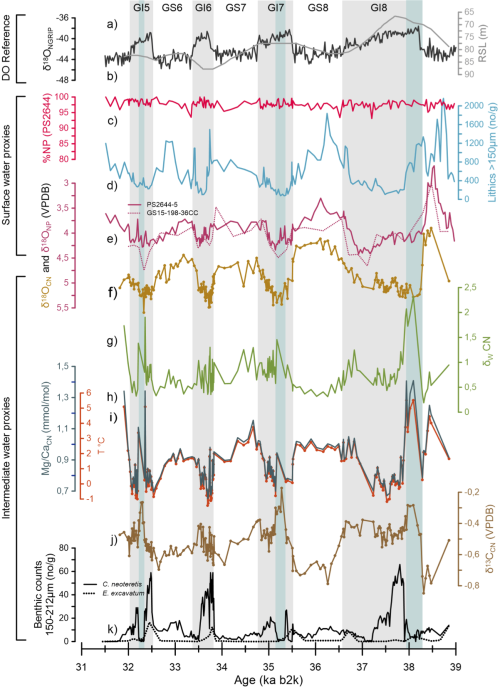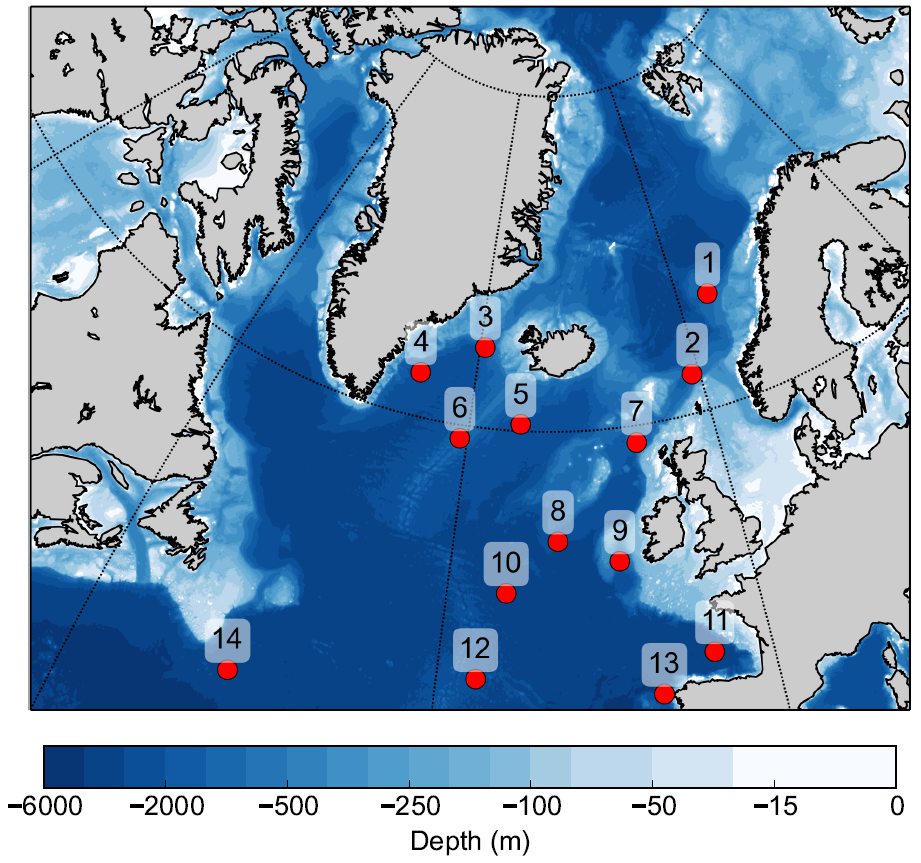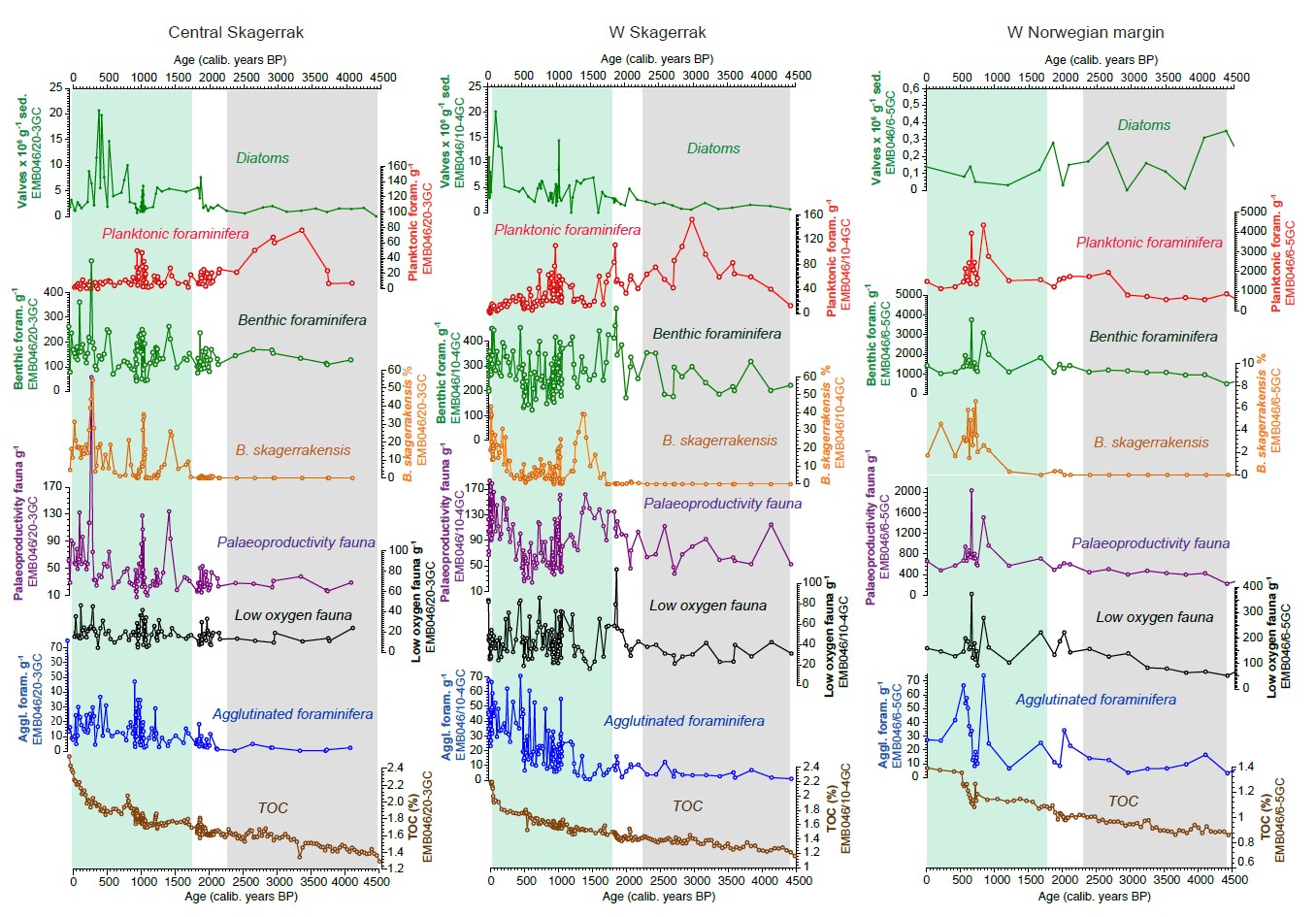12 November 2018
High-Resolution Benthic Mg/Ca Temperature Record of the Intermediate Water in the Denmark Strait Across Dansgaad-Oeschger Stadial-Interstadial Cycles
Sessford et al. have performed a high-resolution, multi-proxy analysis of the sediment core GS15-198-36CC and recently published their results.
The core was retrieved from the northern bank of the Greenland-Iceland Ridge, and exhibits a 30-year temporal resolution during the Dansgaard-Oeschger events 8-5 (40-30 ka). Multiple proxy records were measured for this time period: magnetic susceptibility, oxygen and carbon isotopes for N. pachyderma and C. neoteretis, absolute abundance of benthic species C. neoteretis and E. excavatum, and trace element ratios of benthic species C. neoteretis.
The age model for GS15-198-46CC relies on the published age model established for core PS2644-5 by using magnetic susceptibility tie points. The chronology is refined by stratigraphically tuning the marine magnetic record to the NGRIP δ18O record. The Mg/Ca record, which is the first for benthic species during this time period in this region, indicate warm intermediate water in the Denmark Strait during stadials and cooler water during interstadials. However, while the stadials are quite stable periods, the interstadials exhibit an instability of the water column, rapidly warming and cooling within the first half of the interstadial, and gradually warming throughout the second half. These data are supported by the stable isotopes and absolute abundance counts of the same species, C. neoteretis.
The datasets can be downloaded here.
Their paper is available here.

Down core data set from (a) NGRIP, (c–e), PS2644‐5 and (e–k) GS15‐198‐36CC covering the period between 39 to 31.5 ka and D‐O events 8–5 on the GICC05 (b2k) age scale.
5 July 2018
Sea-surface temperature reconstructions over Dansgaard Oeschger (DO) events 5-8 (30-40 ka)
Jensen et al. have establish a spatio-temporal evolution of the sea-surface temperature anomalies in the North Atlantic over Dansgaard Oeschger (DO) events 5-8 using the proxy surrogate reconstruction method. Also, they have calculated new sea-surface temperature estimates over Dansgaard-Oeschger (DO) events 5-8 from 14 sites in the North Atlantic (see Figure), based on previously published planktic foraminifera relative abundance datasets.
The datasets can be downloaded here.
Their paper is available here.

Core locations of the proxy data.
30.05.2017
Foraminifer, diatom frustules, and total organic carbon of sediment cores in the Norwegian Trench and the Skagerrak
The reconstruction of the late Holocene palaeoproductivity changes in the Skagerrak and the Norwegian Trench provides data of multiple proxies: benthic foraminifera, planktonic foraminifera, diatoms and total organic carbon (TOC) analyzed in 3 sediment cores: EMB046/6-5GC, EMB046/10-4GC and EMB046/20-3GC.
The data are given as nine files: 3 separate files (foraminifera, diatom and TOC) for each of the cores. The datasets can be found here.
Benthic foraminiferal data are presented as relative abundances (%) of Brizallina skagerrakensis and absolute abundances of palaeoproductivity species, low oxygen species, agglutinated taxa and total benthic foraminifera. Palaeoproductivity species include: Alabaminella weddelensis, Brizalina skagerrakensis, Bulimina marginata, Epistominella exigua, Epistominella vitrea, Nonionella iridea, Uvigerina mediterrannea and Uvigerina peregrina. Low oxygen species are grouped by summing together species Adercotryma glomerata, Ammodiscus spp., Bolivina spp., Buccella frigida, Globobulimina auriculata, Globobulimina turgida, Planulina ariminensis, Textularia earlandi, Spiroplectammina biformis and Stainforthia fusiformis.
Planktonic foraminifera and diatoms are given in absolute abundances per g sediment, whilst TOC data are in %.
The dataset has been originally published in:
Polovodova Asteman, I., Risebrobakken, B., Moros, M., Binczewska, A., Dobosz, S., Jansen, E., Sławińska, J., & Bąk, M.: Late Holocene palaeoproductivity changes: a multi-proxy study in the Norwegian Trench and the Skagerrak, North Sea. Boreas, doi:10.1111/bor.12264.
This paper should be cited whenever the data are used.

Proxy data from the sediment cores EMB046/20-3GC; 10-4GC and 6-5GC: benthic foraminifer B. skagerrakensis (%), total organic carbon (TOC) and absolute abundances per gram wet sediment for diatoms, benthic foraminifera indicative of palaeoproductivity, planktonic foraminifera, benthic foraminifera representative for low oxygen conditions, total benthic foraminifera and agglutinated foraminifera. Note different y scale and low diatom abundances due to low silica preservation for the data from the western Norwegian margin. Shaded grey rectangle shows a low productivity period at 4500–2300 years BP, while green rectangle depicts a high productivity period from ~1700 years BP towards present day.





